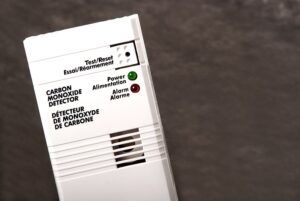Carbon monoxide poisoning is a silent and deadly killer. There have been many publicized examples where people have died suddenly and mysteriously, and some blamed the deaths on carbon monoxide poisoning.
For example, three American tourists died at a Sandals Resort in the Bahamas because of poisoning. They stayed in separate villas and reported feeling unwell the night before they died. One month later, the Royal Bahamian Police Force released the investigation results into their deaths.
Carbon monoxide poisoning kills more than 400 Americans yearly and sends more than 50,000 to the hospital. Carbon monoxide poisoning is deadly and can lead to long-term health impacts for those who survive poisoning.
Symptoms of Carbon Monoxide Poisoning
 Carbon monoxide poisoning can cause the following symptoms:
Carbon monoxide poisoning can cause the following symptoms:
- Headache
- Weakness
- Dizziness
- Nausea
- Shortness of breath
- Confusion
- Blurred vision
- Loss of consciousness
The severe danger associated with carbon monoxide poisoning is that many people sleep when they become sick. They will not wake up because they do not feel the symptoms. Accordingly, the damage occurs when people wake up – if they even wake up again.
Your Carbon Monoxide Detector Is Critical
The carbon monoxide detector is one of the essential things in your home. If the detector does not do its job correctly, it can put you and your family in critical danger. If the carbon monoxide detector does not work or alerts you after it is too late, you may not know your life is in danger. Even when a landlord installs a carbon monoxide detector, they must ensure that it works properly, and they need to test it regularly.
A working carbon monoxide detector is even more critical in the age of COVID-19. There have been some reports that carbon monoxide poisoning symptoms are similar to COVID symptoms, making it more crucial to know when there is a leak in the home.
Some people might not suspect that they are in critical danger because they may think that something else is wrong with them. When some people feel sick at home, they may not take any action, putting themselves in an even more dangerous situation.
Too Many Carbon Monoxide Detectors Do Not Work Properly
What is extremely alarming is the high failure rate of residential carbon monoxide detectors. One study tested 30 detectors to verify which ones worked. Shockingly, the study found that more than half failed to function correctly. Some detectors went off too early, while others alerted to the presence of carbon monoxide too late.
Of course, not alerting people about carbon monoxide in time is a critical and life-threatening problem. Of the annual deaths from carbon monoxide, no one knows how many were the result of a defective detector and how many happened because there was no detector at all.
Even the voluntary standards that the industry proposes and complies with may not be enough to protect people from carbon monoxide poisoning fully. The situation does not improve when companies that make detectors keep having to recall their products, as has happened in the instances described below.
The Number of Recalls Does Not Match the Number of Non-Functioning Detectors
The limited number of recalls in the past decade is even more alarming in the face of obvious evidence that many carbon monoxide detectors do not work as intended. The numbers should make consumers wonder if their detector works. While they can test batteries, they certainly cannot test whether the machine works to detect actual carbon monoxide.
All of this should make you wonder what carbon monoxide detector manufacturers know and what they are not telling consumers. These manufacturers must test their products, especially given the dire consequences of failing.
Universal’s Detectors Did Not Warn of Carbon Monoxide
Recently, a significant recall affected thousands of smoke and carbon monoxide detectors. Eight thousand units made by Universal Security Instruments got recalled because they failed to alarm in the presence of dangerous CO levels. The failure to alert people to a hazardous condition is perhaps the worst thing possible for a carbon monoxide detector. Walmart and other retailers sold the units from 2017 to 2019.
The issue with the Universal Security Instruments detector is not the first serious issue faced by the company. Even though not recalled, another product received a “Do Not Buy” rating from Consumer Reports because it failed to detect carbon monoxide levels in the air. Another model did pass the CR tests.
The CPSC recall followed several reports that the detector did not work correctly. Some of those reports came from Consumer Reports, which tested the product and reported the defects to the government agency. In the wake of the recall, Universal Security Instruments offered consumers a free replacement device.
There Have Been Other Large-Scale Recalls in the Past
The defect described above is far from the first time carbon monoxide detectors were recalled because they failed to work properly. The Universal Security Instruments recall paled compared to the last major carbon monoxide detector recall.
In 2021, Kidde recalled 226,000 smoke alarms and combination smoke and carbon monoxide alarms. This particular recall is related to the fire alert function. Consumers can receive a new alarm system because of the recall. Before that, manufacturers’ safety record was improving, with fewer significant recalls in recent years.
Kidde, a significant carbon monoxide detector seller, has a checkered safety record. Previously, the company had to recall over five million units because the carbon monoxide detector kept beeping, even after it reached the end of its useful battery life, leading consumers to believe that the product was still working. Eight incidents were reported related to the defect, but nobody was hurt. Before that, Kidde recalled over 100,000 carbon monoxide detectors because they went into latched mode during a power outage.
Locally, there are scores of laws that require the installation of carbon monoxide detectors in homes and residences. However, your carbon monoxide detector is only good if it works.
Your carbon monoxide detector is supposed to beep when it is faulty or is not working. Unfortunately, that does not always happen. Even with carbon monoxide detectors, many people still suffer injuries each year. The machines do not let you know that there is a problem. Many people do not know that their detector is not working. Given how quickly carbon monoxide poisoning can severely injure or kill you, they may never know at all.
There Are Multiple Potentially Responsible Parties in Carbon Monoxide Poisoning
If you or a loved one have suffered an injury or a family member has died from carbon monoxide poisoning, an attorney will help you figure out who was to blame for the accident. It should be apparent that the carbon monoxide detector was faulty if there was an injury when the device was supposed to be working.
In addition to the product liability lawsuit for a defective detector, you can hold these parties legally responsible for your injuries:
- The hotel or establishment where the accident happened
- The landlord whose legal obligation it was to test and inspect the carbon monoxide detector
- The maker of the household appliance or heater that caused the carbon monoxide poisoning (in another product liability lawsuit)
Even if you did not directly buy the carbon monoxide detector yourself (it was installed in your apartment by the landlord), you can still sue the unit’s manufacturer in a product liability lawsuit. It used to be that you had to be in privity of contract with the seller, meaning that you bought the defective product directly from them.
The more recent rule in product liability cases is that you can still sue for negligence if a negligently made product, is likely to cause injury to a class of persons that includes you. Even if you can not sue directly for a defective product, there is still a way to hold the manufacturer legally accountable for not doing its job correctly and causing injury.
There may be multiple potential defendants at once. You should sue everyone who was potentially responsible and cast a wide net in your attempts to obtain financial compensation.
You Can Sue Anyone Involved in the Sale of a Defective Carbon Monoxide Detector
Concerning the defective carbon monoxide detector, you can sue the manufacturer or the store where you bought it if you purchased it yourself. The rule in a product liability case is that anyone in the “stream of commerce” is legally responsible for your injuries. While most people sue the manufacturer, they also add the retailer to the lawsuit.
Even sellers have a legal liability for defective carbon monoxide detectors. For example, the federal government has taken action against Amazon because they continued to sell defective carbon monoxide detectors made by a Chinese company and refused to recall them.
Although courts may disagree on whether you can sue Amazon for a Marketplace transaction, courts have recently allowed lawsuits against intermediaries like Amazon that profit from allowing merchants to use their platform.
Three Defects for Which You Can Sue
If you were going to sue the carbon monoxide detector manufacturer, you can win your lawsuit if you can show the product itself was defective. If you can make this showing, the manufacturer will be strictly liable for the damages you suffer.
There are three product defects:
- Design defects – There is an inherent defect in the design. When an alternate design will be safer, economically feasible, and practical
- Manufacturing defects – Nothing is wrong with the product design, but something went wrong with the manufacturing process that caused the defect.
- Marketing defects – The manufacturer has given inadequate safety instructions, or they know (or should have known) about possible defects and do not recall the device or warn the general public.
In any product liability lawsuit, the burden of proof will be on you to prove that the product was defective. Carbon monoxide detectors should work as intended, and nobody should be sickened or injured when they have installed a properly working carbon monoxide detector. Nonetheless, you will need an attorney to show precisely how the detector failed to work when it should have. The manufacturer may blame you, claiming that you did not properly use or maintain the device.
You will be unable to file a lawsuit just for a carbon monoxide detector that does not work. First, you will need to suffer an injury to sue.
Compensation in a Defective Carbon Monoxide Detector Lawsuit
Your attorney will also help quantify your damages so you know how much to seek in a product liability case.
In any product liability case, you can receive the following in damages if you win or settle your lawsuit:
- Medical bills
- Lost wages
- Pain and suffering
- Loss of enjoyment of life
If a family member died in a carbon monoxide poisoning accident, and they had installed a detector, you can sue the manufacturer in a wrongful death claim. Then, your family will be paid back for your losses when you lose a loved one because of someone else’s wrongful actions. The most important part of your case is when you can hire an experienced product and premises liability attorney to take decisive legal action against the responsible parties.

Do Not Wait to Seek Legal Help
If you suffered injuries due to a defective carbon monoxide detector or another defective product, you need legal representation immediately. Time is of the essence in these cases, as your lawyer will need to gather technical evidence and information to prove the cause of your injuries.
Consultations with injury attorneys are free with no obligation, so you have nothing to lose by having a legal team evaluate your rights. Take action today to hold companies accountable for defective product injuries.
